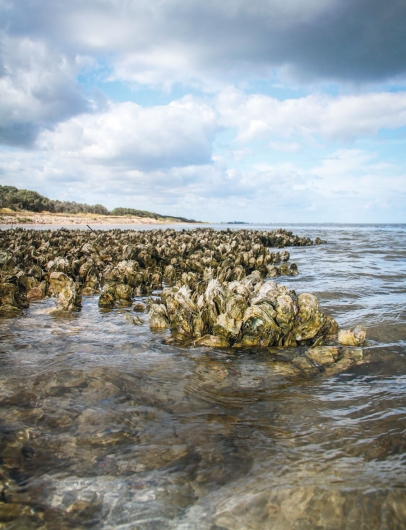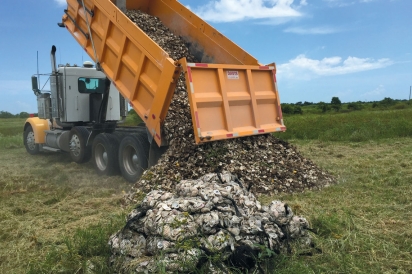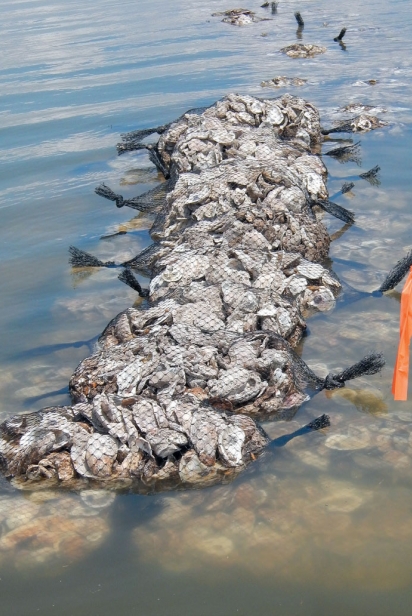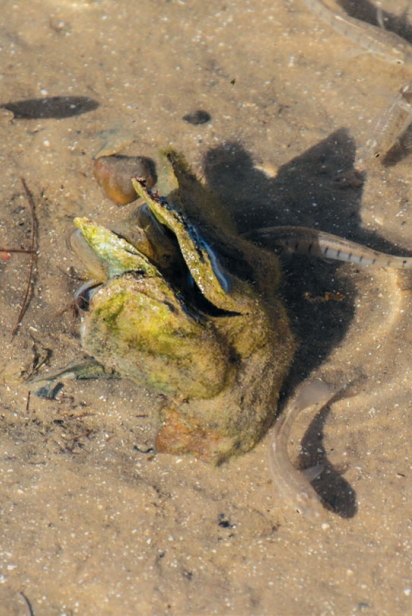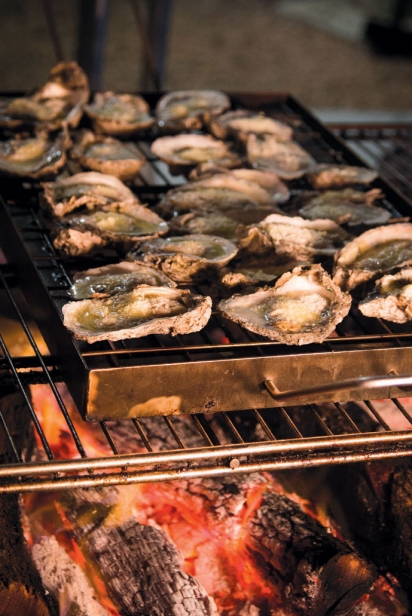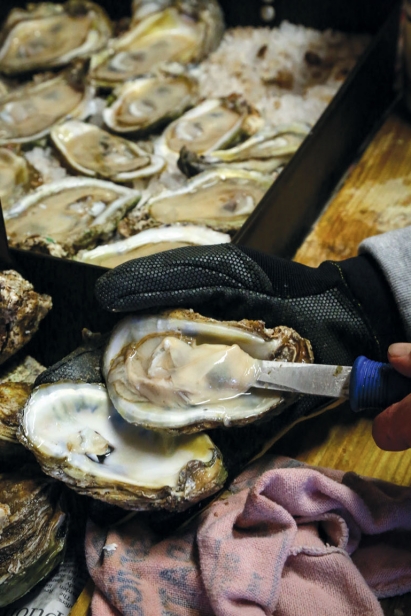An Ode to Oysters
’Tis the season to rhapsodize over oysters
I’m standing in the Armadillo Palace’s cavernous barroom, queuing up in front of four 35-gallon galvanized tubs on a thick-hewn wooden sideboard. Glistening atop the chipped ice in the tubs lie dozens of freshly shucked oysters, shimmering in briny pools of their own half shells. Four oyster shuckers stand behind the massive table, deftly replenishing the array.
“Many folks don’t realize that oysters are what drives Texas’s $1.9 billion recreational saltwater fishery,” says Ted Venker, who’s standing next to me as I slurp down a plump Hannah’s Reef oyster.
Venker does: As conservation director of the Coastal Conservation Association (CCA), Houston native and ardent angler, he’s a frontline advocate for healthy marine ecosystems. CCA—a four-decade-old nonprofit with 17 coastal chapters along the Atlantic and Pacific seaboards and the Gulf of Mexico—will be the initial beneficiary of this evening’s fundraiser, their sleeves to begin healing the bay. Their biggest ally? The oyster.
Cornerstones of the Coast
Indeed, the lowly oyster does a yeoman’s job. As an adult oyster passes seawater over its gills and through hair-like cilia in its continual search for calcium carbonate to keep building its shell and for the plankton and algae on which it feeds, it coats any non-food impurities with mucus and then expels them as little waste packets that sink into the bay’s sediment. In doing so, each oyster returns approximately 50 gallons per day of cleansed, filtered water to the bay.
“Oysters are the unsung heroes of our oceans for the vital role they play in protecting our shorelines and the health of our marine environment,” says Laura Huffman, Texas state director for The Nature Conservancy. “When we restore just one 15-acre oyster reef, that reef has the potential to filter as much water per day as the entire dubbed “Oysters, Blues & Brews: A Gulf Coast Celebration” and sponsored by Goode Co., the Armadillo Palace’s parent company, to kick off this year’s oyster season.
Worldwide, 85% of oyster reefs have vanished, making them the most severely impacted marine habitat on the planet. Adding insult to injury, Hurricane Ike savaged Galveston Bay’s oyster population in 2008, burying nearly two-thirds of them in an aquatic avalanche of sediment, muck and debris and ravaging the entire estuary; 80% of East Galveston Bay’s oyster reefs were obliterated.
That year, Texas’ commercial oyster harvest—which is dominated by Galveston Bay—plummeted by more than half (from 2,555.3 metric tons in 2007 to 1,215.3 in 2008). Galveston Bay’s post-Ike restoration costs skyrocketed into several hundred million dollars, and an interlaced consortium of nonprofits, advocacy groups and government agencies including CCA, the Texas Nature Conservancy, the Galveston Bay Foundation, Texas A&M SeaGrant, Texas Parks and Wildlife Department, and the U.S. Fish & Wildlife Service, among others, rolled up Houston metroplex uses on an average summer day. The reefs created by these hardworking shellfish also provide a natural barrier to storm surges and support a bevy of other marine life including crab, shrimp and small finfish, which in turn attract larger fish. That’s why ‘fishing the reefs’ is tremendously popular among anglers.
“In the Gulf, we’re actually in better shape than anywhere else in the world,” Huffman continues. “We still have roughly 50% of our historical reefs intact, which is one of the reasons why the Gulf of Mexico is widely considered as the last, best hope for a full comeback. And we’re wasting no time on that front. Next year, The Nature Conservancy, Texas Parks and Wildlife and the Galveston Bay Foundation are undertaking a 40-acre oyster reef restoration project in the upper portion of Galveston Bay. This part sanctuary, part harvestable reef will bolster the ecological health of bay while providing new opportunities for sustainably harvested oysters.”
Oysters have been successfully farmed for centuries, as once the developing oyster (known as spat) attaches to a substrate, there it remains, colonizing with other oysters to build a reef—purifying water, creating marine habitat, protecting coastlines. Furthermore, oysters are one of the few seafoods of which both farmed and wild-caught stocks earn “Best Choice” ratings from the Monterey Bay Aquarium Seafood Watch, as the benefits to the aquatic environment are equally beneficial.
Those of us who salivate at the thought of fresh, plump, briny oysters will just have to be patient while the oysters work. Unlike that tasty pink crustacean, the shrimp, which reaches harvestable size in a matter of months, an oyster takes three to four years to mature.
Among the five species of oysters that make their way to our tables, the Eastern oyster (Crassostrea virginica) might well be called America’s oyster: C. virginica grows from Canada on down the Eastern seaboard and throughout the Gulf. In one of nature’s more fascinating reproductive mechanisms, oysters are protandric hermaphrodites, born as males and completing their first breeding cycle thus, and then gradually becoming females as they mature with some even reverting to male. In spring through early summer, males and females put energy into growing gonad (reproductive tissue, which is not so tasty) for the summer spawn. Post-spawn, they’ll convert to producing glycogen, a form of glucose stored for energy, instead—giving them the sweet taste so beloved in the “R” months.
Oysters may spawn several times during the summer months, and when one starts to spawn it triggers the surrounding ones, with each male releasing hundreds of millions of sperm, and females up to 114 million eggs. Fertilized eggs start as microscopic larvae, floating in the water column. Over the next few weeks, they enter the veliger phase, developing cilia for feeding and for filtering calcium carbonate from which they create thin shells. Next, they’ll develop eye spots and a foot to become “pediveligers,” and begin seeking a suitable habitat—with oyster shell, called “cultch,” being a preferred habitat. Once they cement themselves to the substrate, they’re known as “spat,” and their choice becomes their permanent home—come tempest, tide or drought—for up to 20 years.
That is, if they don’t get eaten first.
A Look in the Merroir
When it comes to eating, not all C. virginica are created equal. Just as with wine varietals that are imbued with terroir (characteristics of the soil and climate in which they’re grown), oysters develop merroir, taking on distinct flavors depending upon mineral content, available nutrients, and the salinity and temperature ranges unique to their own specific marine environment.
The longtime custom of branding Eastern oysters with appellations (the name of their home water body) not only continues, but has expanded into the Gulf of Mexico, offending some of the oyster cognoscenti who reverently claim the superiority of Cape Cod Wellfleets, Long Island Bluepoints, Chesapeake Rappahannocks and so on.
Arguably—and argue I will—our Galveston Bay oysters are among the best in the nation, larger and more succulent than their East Coast cousins.
On a sojourn to the Chesapeake Bay a few years back, I quietly set about proving my case … literally, with wooden cases. My old college pals (neither from Texas) and I had slurped up several dozen raw oysters to their ooohs and aaahs about the amazing Chesapeake oysters, paid our check, and embarked to explore the quaint seaside town. Puzzled when I suggested strolling down the back alley behind the imposing row of harborside restaurants, they burst into gales of laughter as I pointed to empty wooden case after wooden case behind the restaurants. Emblazoned across each case: Jeri’s Seafood, Smith Point, Galveston Bay, Texas. Case closed.
“People tend to think of Gulf oysters as being so generic,” says Bobby Matos, executive chef at the River Oaks eatery State of Grace, which sports a posh sunlit oyster bar with well-padded stools rimming an arc of iced-down appellation oysters. “But they’re not; there’re subtle and not-so-subtle differences. We communicate this to our guests through waiter education, so they can pass along this knowledge to our guests, much as we do with our wines. Our Galveston Bay oysters are hand-selected through [Dickinson-based] Prestige Oyster's Inc, and we buy other Gulf oysters—Louisiana, Alabama and, soon, Mississippi—through Louisiana Seafood.”
That being said, sometimes only a direct taste test will do, and that’s what I’m doing this evening at the Armadillo Palace. Each of the four gargantuan galvanized tubs displays appellation oysters: There’s delicate Sister Lake, Louisiana, oysters with nearly imperceptible brininess and Crockett Bay, Alabama, ones that are a tad more assertive and plump. Those two might appeal to the broadest range of tastes; however, my favorites were the brinier, meatier Mississippi oysters from Henderson Point and those from Hannah’s Reef in our own Galveston Bay. Choose the merroir you like: They’ll range from the near-floral, low mineral and salt of a mermaid’s kiss to the bold, briny blast that Robb Walsh, author of Sex, Death & Oysters, affectionately describes as “akin to licking the bottom of a boat.”
From Restaurants to Reefs
To address the rebuilding of Galveston Bay’s oyster reefs after Hurricane Ike, the Galveston Bay Foundation began an innovative oyster shell collection program with Houston area restaurants: You see, one recycled oyster shell can provide substrate for 10 spat (baby oysters). By creating new reefs with bagged oyster shells, they not only create new oyster habitat, but build reefs that protect the coastline against storm surges and erosion.
GBF’s Habitat Restoration Coordinator Haille Carter explains the process: “We provide shell-recycling bins [either 32-gallon bins or five-gallon buckets] to participating restaurants, and pick them up on a weekly basis. Once the shells are collected, they’re sun-dried for a minimum of six months to ensure that all bacteria and any nonnative species have been destroyed. Following the curing process, they’re either hauled directly to a restoration site to help the oysters’ life cycle begin anew, or packaged in mesh bags and given to bayside ‘foster parents’ for the summer.
“In the summer, there’s a remarkable amount of microscopic fertilized oyster eggs in the near-shore water column,” she continues. “The foster parents hang the bags off their docks all summer, and love seeing how much oyster spat has grown by fall.” GBF hosts a volunteer day in the fall to put the seeded oyster bags out to become reefs.
Since beginning the oyster shell recycling program in 2011, the Galveston Bay Foundation has reclaimed more than 500 tons of oyster shell with the help of area seafood restaurants. Currently, six restaurants participate in the GBF program: The Aquarium, Capt. Benny’s Seafood, Crazy Alan’s Swamp Shack, Tommy’s Restaurant & Oyster Bar, Tookie’s Seafood, and Topwater Grill.
Other restaurants, such as Houston’s beloved Goode Company, recycle oyster shell directly through their suppliers. The two largest commercial oyster purveyors in Galveston Bay, Jeri’s Seafood and Prestige Oysters, have replenished Galveston Bay by returning an estimated 100,000 tons of oyster shell—and rock during the summer, while oysters are spawning—over the past four years, not only from their own shucking operations, but also from the restaurants they supply.
Texas commercial oyster production is recovering, albeit slowly—our state’s commercial harvest topped 1,872.9 metric tons in 2014, a 54% uptick since Ike’s decimation. Huge swaths (TX1, TX4, TX5 and TX6, which comprise East Bay in its entirety and the western part of Galveston Bay from southeast from Baytown at Umbrella Point to Dollar Point just north of Texas City) remain closed to harvest, with the exceptions being granted by TPWD for private commercial oystermen, who grow, cultivate and harvest oysters they have planted themselves.
Still, there’s reason for great hope, as oysters continue to “get by with a little help from their friends.” Not only do these modest marine mollusks delight our palates, but are the ultimate givers—cleaning our water, creating habitat and protecting our coastlines.
Eat them or not, that’s reason enough to make anyone an oyster lover.


